
Biography
Biography: Jun Xu
Abstract
This talk introduces a de novo chemotype (substructure) generation algorithm (DSGA) that derives frequent substructures in order to avoid the subjectivity of empirical method, and avoid the meaningless substructures generated from algorithmic approaches by statistical analyses. DSGA derives frequent chemical substructures (FCS) from a large compound library. In a FCS, substructures are not inter-included. When the library is big enough to represent the chemical diversity, such as ZINC database (27 million medicinal compounds), the resulting FCS is termed as the FCS dictionary (FCSD) for drug-like compounds. For a focused compound library (FL), DSGA can derive a focused FCS (fFCS) from FL. fFCS can be used as structural descriptors for focus library SAR studies.
Six focused libraries against targets PDE4D, mTOR, HDAC1, DPP4, BACE and ALR2 were tested with DSGA approach. Using the fFCSs as structural descriptor sets, six virtual screening models were generated to predict ligands against the targets, the prediction accuracies are greater than 90%.
Three methods were proposed to assembly drug-like molecules from substructures: (1) using the laws in the nature, such as isoprene rule; (2) organic synthesis rules, such as retro-synthon rules proposed by E. J. Corey; (3) pharmaceutical rules derived from a focused compound library against a specific target. We use DSGA to figure out rules that are used to compose privileged scaffolds by assembling FCS.
It can be chemically challenging to make the compounds proposed by these assembling approaches. By combining DSGA method, bioisoterism method and click chemistry, we generated privileged chemome (substructures/chemotypes) from Hsp90 inhibitor library, then find out available chemical fragments with bioisoterism rules. With SPR technology, we confirmed the fragments that interacted with Hsp90. Finally, we used Click chemistry to assembly the substructures, and produced nanomolar selective Hsp90 inhibitors.

